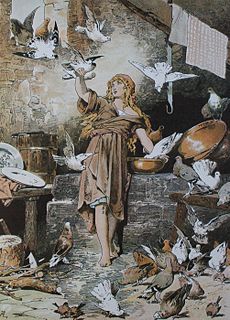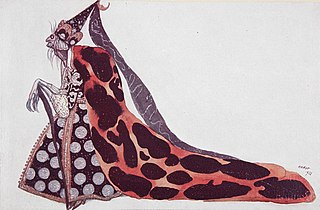Synopsis
A girl's parents having died, was raised by her godmother, who died, leaving her the house and a spindle, a shuttle, and a needle to earn her living. She did quite well at it.
One day, a king's son came looking for a bride. He wanted one who was at once the richest and the poorest. In this village, they pointed out the richest girl, and then the orphan girl. He rode by the richest girl, who bowed to him, and he rode on. He rode by the poorest girl, who was spinning. When she saw he was looking at her, she blushed and closed her eyes. He rode by, and she opened the window, saying it was hot, but watching until he left.
Then she remembered rhymes her godmother had used. She set the spindle to guide the prince back by its golden thread, the shuttle to weave a path to her hut, and the needle to adorn the hut. When the prince returned, he said she was both the richest and the poorest, and married her. The spindle, shuttle, and needle were kept in the royal treasury.

"Cinderella", or "The Little Glass Slipper", is a folk tale with thousands of variants throughout the world. The protagonist is a young woman living in forsaken circumstances that are suddenly changed to remarkable fortune, with her ascension to the throne via marriage. The story of Rhodopis, recounted by the Greek geographer Strabo sometime between around 7 BC and AD 23, about a Greek slave girl who marries the king of Egypt, is usually considered to be the earliest known variant of the Cinderella story.

Sleeping Beauty, or Little Briar Rose, also titled in English as The Sleeping Beauty in the Woods, is a classic fairy tale about a princess who is cursed to sleep for a hundred years by an evil fairy, to be awakened by a handsome prince at the end of them. The good fairy, realizing that the princess would be frightened if alone when she awakens, uses her wand to put every living person and animal in the palace asleep, to awaken when the princess does.

Mention of textiles in folklore is ancient, and its lost mythic lore probably accompanied the early spread of this art. Textiles have also been associated in several cultures with spiders in mythology.

In fairy tales, a fairy godmother is a fairy with magical powers who acts as a mentor or parent to someone, in the role that an actual godparent was expected to play in many societies. In Perrault's Cinderella, he concludes the tale with the moral that no personal advantages will suffice without proper connections.

Prince Charming is a fairy tale stock character who comes to the rescue of a damsel in distress and must engage in a quest to liberate her from an evil spell. This classification suits most heroes of a number of traditional folk tales, including "Snow White", "Sleeping Beauty", and "Cinderella", even if in the original story they were given another name, or no name at all.
The Little Lame Prince and his Travelling Cloak is a story for children written by Dinah Maria Mulock Craik and first published in 1875. In the story, the young Prince Dolor, whose legs are paralysed due to a childhood trauma, is exiled to a tower in a wasteland. As he grows older, a fairy godmother provides a magical travelling cloak so he can see, but not touch, the world. He uses this cloak to go on various adventures, and develops great wisdom and empathy in the process. Finally he becomes a wise and compassionate ruler of his own land.
"The Goose-Girl at the Well" is a German fairy tale collected by the Brothers Grimm. It is Aarne-Thompson type 923.
The Child who came from an Egg or The Egg-Born Princess is an Estonian fairy tale, collected by Dr. Friedrich Reinhold Kreutzwald in Eestirahwa Ennemuistesed jutud.
Finette Cendron is a French literary fairy tale written by Madame d'Aulnoy.

The Feather of Finist the Falcon or Finist the Falcon is a Russian fairy tale collected by Alexander Afanasyev in Narodnye russkie skazki. It is Aarne–Thompson type 432, the prince as bird. Other tales of this type include The Green Knight, The Blue Bird, and The Greenish Bird.

The Wicked Fairy Godmother or the Wicked Fairy, a rare figure in fairy tales, is nevertheless among the best-known figures from such tales because of her appearance in one of the most widely known tales, Sleeping Beauty, and in the ballet derived from it. Anonymous in her first appearance, she was later named in some variants Carabosse and is called Maleficent in Walt Disney media.

The Fairy Godmother is a novel by Mercedes Lackey, published in 2004 and the first book of the Tales of the Five Hundred Kingdoms series.
The Lassie and Her Godmother is a Norwegian fairy tale collected by Peter Christen Asbjørnsen and Jørgen Moe in Norske Folkeeventyr.
Bearskin is a French literary fairy tale by Marie-Madeleine de Lubert. It was included in her revised edition, published in 1753, of Henriette-Julie de Murat's last novel, Les Lutins du château de Kernosy, which is why it is often attributed to Madame Henriette-Julie de Murat.

Cinderella is an Italian-Japanese 1996 anime television series based on the fairytale of the same name by Charles Perrault and The Brothers Grimm. It was produced by Tatsunoko Productions and Mondo TV. The series originally aired from April 4 to October 3, 1996, comprising 26 episodes.

Hey, Cinderella! is a 1969 television special adaptation of the fairy tale Cinderella, produced by Henson Associates in the United States and Robert Lawrence Productions in Canada, and featuring The Muppets created by Jim Henson, who also directed the special. It was written by Jon Stone and Tom Whedon, and scored by the music composer of Sesame Street, Joe Raposo. It featured Kermit in his first appearance as a frog, as well as Goshposh and Rufus and Splurge.

Cinderella is a 1914 silent film starring Mary Pickford, directed by James Kirkwood Sr., produced by Daniel Frohman, and released by Famous Players Film Company. The film is based upon the fairy tale Cinderella. The film was released on Blu-ray & DVD as a bonus feature from the DVD of Through the Back Door (1921). It was previously released on DVD by Alpha Video.

Märchen is the seventh story CD, released by the fantasy symphonic rock band Sound Horizon on December 15, 2010 through King Records. The normal edition debuted No. 3 and peaked No. 2 on the Oricon weekly album charts. While the Limited edition sold over 40,000 copies in the first two days, 24,816 copies on the first day, 15,833 copies on the next.

The Land of Stories is a series of children's fiction, adventure and fantasy books written by American author, actor and singer Chris Colfer. The first book, The Wishing Spell, was released on July 17, 2012. The sixth book was published in July 2017. During a live video chat, Colfer revealed plans for a prequel series, which have now been published. The books are described by Colfer as a "modern-day fairy tale", following twins Alex and Conner Bailey as they fall from the real world into a world full of fairy tales they have only ever read about before and discovering there is more to this world than meets the eye.












